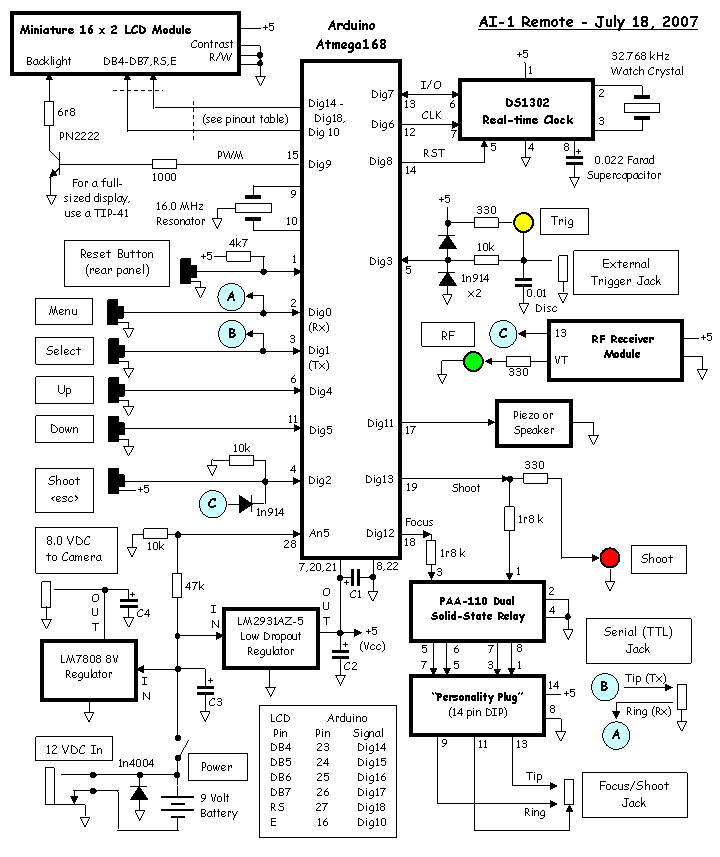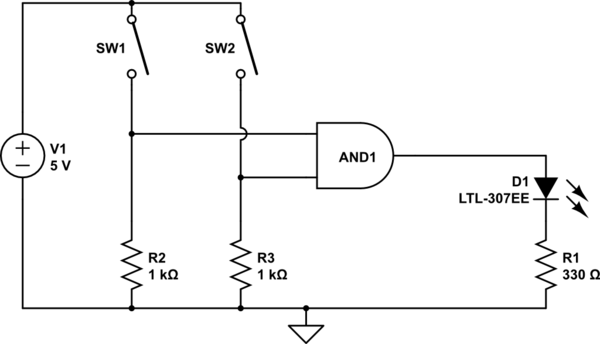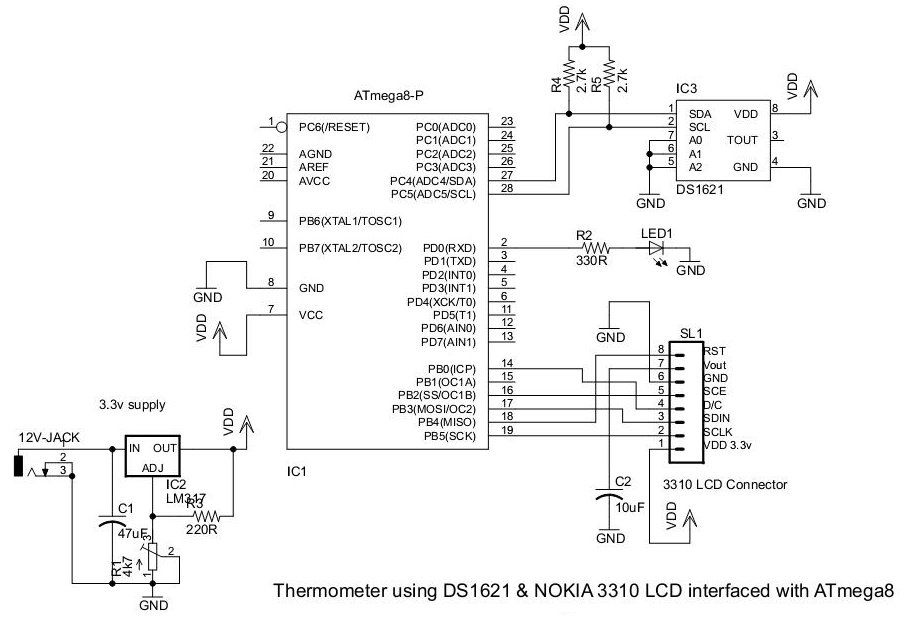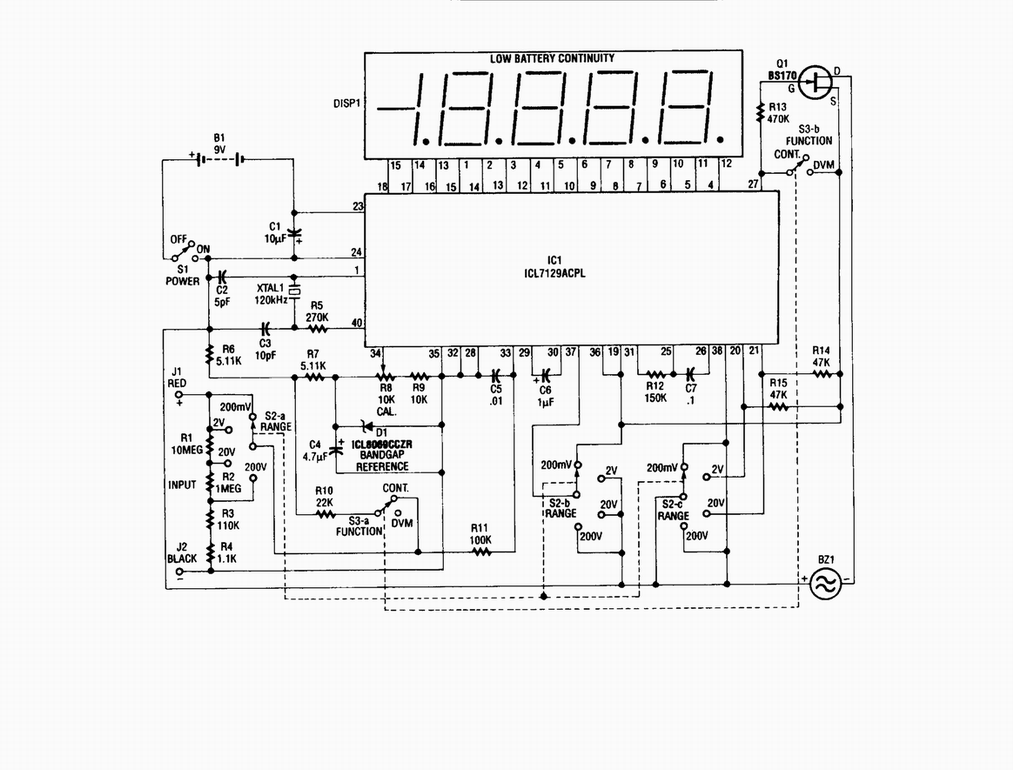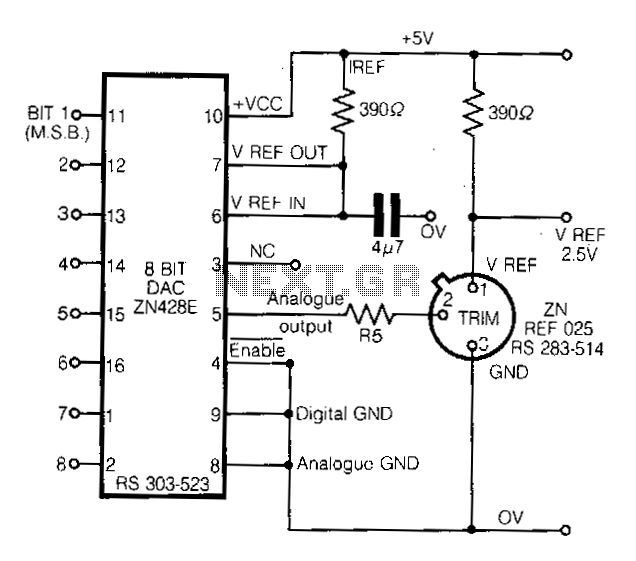
Digital Remote Thermometer
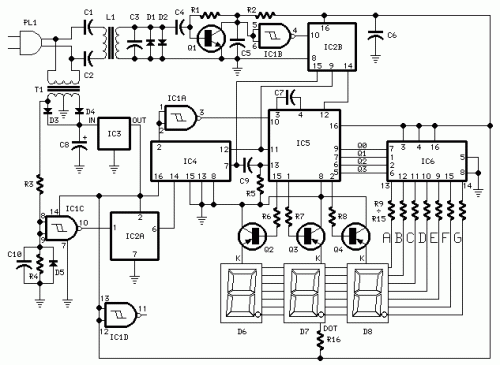
This circuit is designed for precise centigrade temperature measurement. It features a transmitter section that converts the sensor's output voltage, which is proportional to the measured temperature, into frequency. The output frequency bursts are transmitted through the mains supply cables. The receiver section counts these bursts and displays the count on three 7-segment LED displays. The least significant digit shows tenths of a degree, allowing for a temperature range of 00.0 to 99.9 °C. IC1 serves as a precision centigrade temperature sensor with a linear output of 10mV/°C, driving IC2, a voltage-frequency converter. At its output pin (3), an input of 10mV is converted into 100Hz frequency pulses. For instance, a temperature of 20 °C results in IC1 outputting 200mV, which IC2 then converts to 2KHz. Q1 functions as the driver for the power output transistor Q2, which is coupled to the mains supply through L1 and capacitors C7 and C8. The frequency pulses from the mains supply are safely insulated by capacitors C1, C2, and inductor L1, and are amplified by Q1, with diodes D1 and D2 limiting input peaks. The pulses are filtered by capacitor C5, squared by IC1B, divided by 10 in IC2B, and sent to the clock input of IC5 for final counting. IC4 acts as the time-base generator, providing reset pulses for IC1B and IC5, and enabling latches and gate-time of IC5 at a frequency of 1Hz. It is driven by a 5Hz square wave derived from the 50Hz mains frequency, picked up from the secondary of transformer T1, squared by IC1C, and divided by 10 in IC2A. IC5 controls the cathodes of the displays through transistors Q2, Q3, and Q4 at a multiplexing rate determined by capacitor C7. It also drives the anodes of the three displays in parallel through the BCD-to-7 segment decoder IC6.
The circuit operates with a high degree of precision, leveraging the linear characteristics of the temperature sensor to produce an accurate frequency output that reflects the temperature measurement. The choice of a voltage-frequency converter allows for effective transmission of temperature data over the mains supply, facilitating remote monitoring capabilities. The use of multiplexing for the LED displays ensures that the circuit remains compact while providing clear visual feedback on the temperature readings.
The design incorporates various protection and filtering elements, such as diodes and capacitors, to ensure stable operation and to prevent damage from voltage spikes. The time-base generator IC4 plays a crucial role in synchronizing the operation of the counting and display functions, ensuring that the temperature readings are updated at a consistent rate. The BCD-to-7 segment decoder further simplifies the display logic, allowing for a straightforward interpretation of the temperature data.
In summary, this circuit is a sophisticated solution for temperature measurement, combining precision sensing, frequency conversion, and effective display technologies to provide reliable and accurate temperature readings in a compact format.This circuit is intended for precision centigrade temperature measurement, with a transmitter section converting to frequency the sensor`s output voltage proportional to the measured temperature. The output frequency bursts are conveyed into the mains supply cables. The receiver section counts the bursts coming from mains supply and shows the coun ting on three 7-segment LED displays. The least significant digit displays tenths of degree and then a 00. 0 to 99. 9 C range is obtained. IC1 is a precision centigrade temperature sensor with a linear output of 10mV/ C driving IC2, a voltage-frequency converter. At its output pin (3), an input of 10mV is converted to 100Hz frequency pulses. Thus, for example, a temperature of 20 C is converted by IC1 to 200mV and then by IC2 to 2KHz. Q1 is the driver of the power output transistor Q2, coupled to the mains supply by L1 and C7, C8. The frequency pulses coming from mains supply and safely insulated by C1, C2 & L1 are amplified by Q1; diodes D1, D2 limiting peaks at its input.
Pulses are filtered by C5, squared by IC1B, divided by 10 in IC2B and sent for the final count at the clock input of IC5. IC4 is the time-base generator: it provides reset pulses for IC1B and IC5 and enables latches and gate-time of IC5 at 1Hz frequency.
It is driven by a 5Hz square wave obtained from 50Hz mains frequency picked-up from T1 secondary, squared by IC1C and divided by 10 in IC2A. IC5 drives the displays` cathodes via Q2, Q3 & Q4 at a multiplexing rate frequency fixed by C7. It drives also the 3 displays` paralleled anodes via the BCD-to-7 segment decoder IC6. 🔗 External reference
The circuit operates with a high degree of precision, leveraging the linear characteristics of the temperature sensor to produce an accurate frequency output that reflects the temperature measurement. The choice of a voltage-frequency converter allows for effective transmission of temperature data over the mains supply, facilitating remote monitoring capabilities. The use of multiplexing for the LED displays ensures that the circuit remains compact while providing clear visual feedback on the temperature readings.
The design incorporates various protection and filtering elements, such as diodes and capacitors, to ensure stable operation and to prevent damage from voltage spikes. The time-base generator IC4 plays a crucial role in synchronizing the operation of the counting and display functions, ensuring that the temperature readings are updated at a consistent rate. The BCD-to-7 segment decoder further simplifies the display logic, allowing for a straightforward interpretation of the temperature data.
In summary, this circuit is a sophisticated solution for temperature measurement, combining precision sensing, frequency conversion, and effective display technologies to provide reliable and accurate temperature readings in a compact format.This circuit is intended for precision centigrade temperature measurement, with a transmitter section converting to frequency the sensor`s output voltage proportional to the measured temperature. The output frequency bursts are conveyed into the mains supply cables. The receiver section counts the bursts coming from mains supply and shows the coun ting on three 7-segment LED displays. The least significant digit displays tenths of degree and then a 00. 0 to 99. 9 C range is obtained. IC1 is a precision centigrade temperature sensor with a linear output of 10mV/ C driving IC2, a voltage-frequency converter. At its output pin (3), an input of 10mV is converted to 100Hz frequency pulses. Thus, for example, a temperature of 20 C is converted by IC1 to 200mV and then by IC2 to 2KHz. Q1 is the driver of the power output transistor Q2, coupled to the mains supply by L1 and C7, C8. The frequency pulses coming from mains supply and safely insulated by C1, C2 & L1 are amplified by Q1; diodes D1, D2 limiting peaks at its input.
Pulses are filtered by C5, squared by IC1B, divided by 10 in IC2B and sent for the final count at the clock input of IC5. IC4 is the time-base generator: it provides reset pulses for IC1B and IC5 and enables latches and gate-time of IC5 at 1Hz frequency.
It is driven by a 5Hz square wave obtained from 50Hz mains frequency picked-up from T1 secondary, squared by IC1C and divided by 10 in IC2A. IC5 drives the displays` cathodes via Q2, Q3 & Q4 at a multiplexing rate frequency fixed by C7. It drives also the 3 displays` paralleled anodes via the BCD-to-7 segment decoder IC6. 🔗 External reference
